
Home » Blog » Boat maintenance & DIY » How to careen a sailboat – the low cost haulout

How to careen a sailboat – the low cost haulout
By Author Guest Post
Posted on Last updated: August 23, 2023
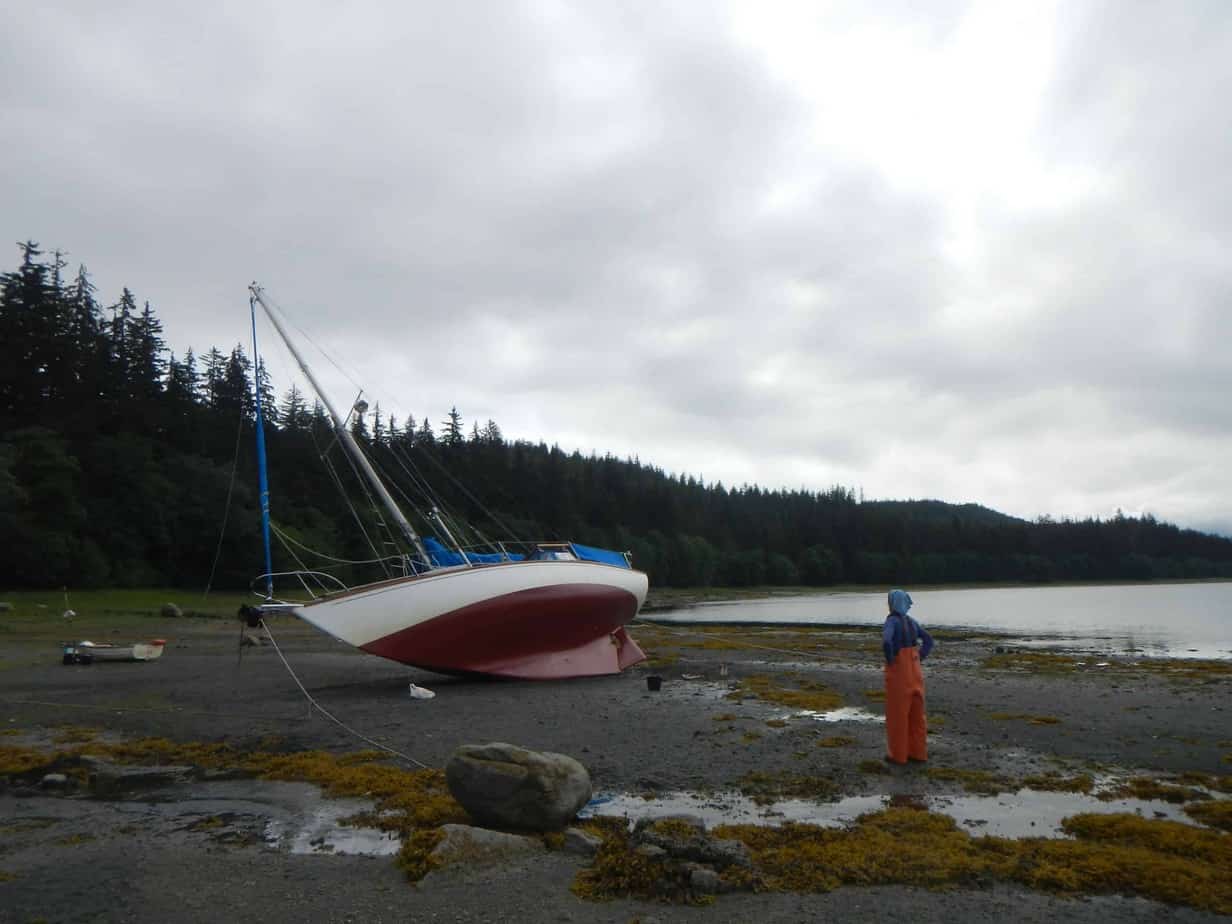
How to careen a sailboat
Usually, I can talk my wife, Kara, into a refreshing swim to defoliate the fouled hull. And was it ever foul; over the winter some sort of orange slime infestation had coated Orca’s sleek hull in what looked like melted cheese.
Kara is usually an avid snorkler, but I was getting nowhere in this quest for a spring hull cleaning. Obviously, her bikini was unsuitable. I admitted that even her wetsuit would be insufficient, but I’d hatched a brilliant plan for Kara to wear my larger wetsuit over hers. How else were we going to get a winter’s growth cleared off in this tiny corner of Alaska?
With an eye roll, Kara set off down the dock to talk to someone who wasn’t an idiot. We’d made lots of friends, mostly because kind locals had been stopping by all winter to donate clothes. When the two California kids sailed into town from Hawai’i, in October, wearing cotton tee-shirts and boardshorts, the community decided they’d have to take action. We were a great source of winter entertainment.
We talked to Blaine and Monique, permanent liveaboards and professional sailing charter captains with Sound Sailing . They were clear on two things: first, in Alaska, it’s considered bad form to go overboard under any circumstances–even the harbors often have significant tidal currents. Secondly, those same tides obviate the need for Travelifts.
Sure, Orca had been aground before. Embarrassingly often, actually, and sometimes quite traumatically. But it hadn’t really occurred to me to do it on purpose. And on a falling tide, no less? The price tag on this approach, however, was intriguing.
We chose a tiny tide pool of an anchorage fringed by dense, presumably bear-infested woods. The shoreline was hard sand and flat, though there were a few glacial erratics littered about. Leaving the boat anchored, we walked the area at low tide and had several days of “lively discussion.” Finally, I pounded a tall cedar stake into the agreed patch of shoreline. We tied a handkerchief exactly 4’3” above the sand, marking Orca’s draft. We looped line around a nearby boulder and left the end to float on a fender.
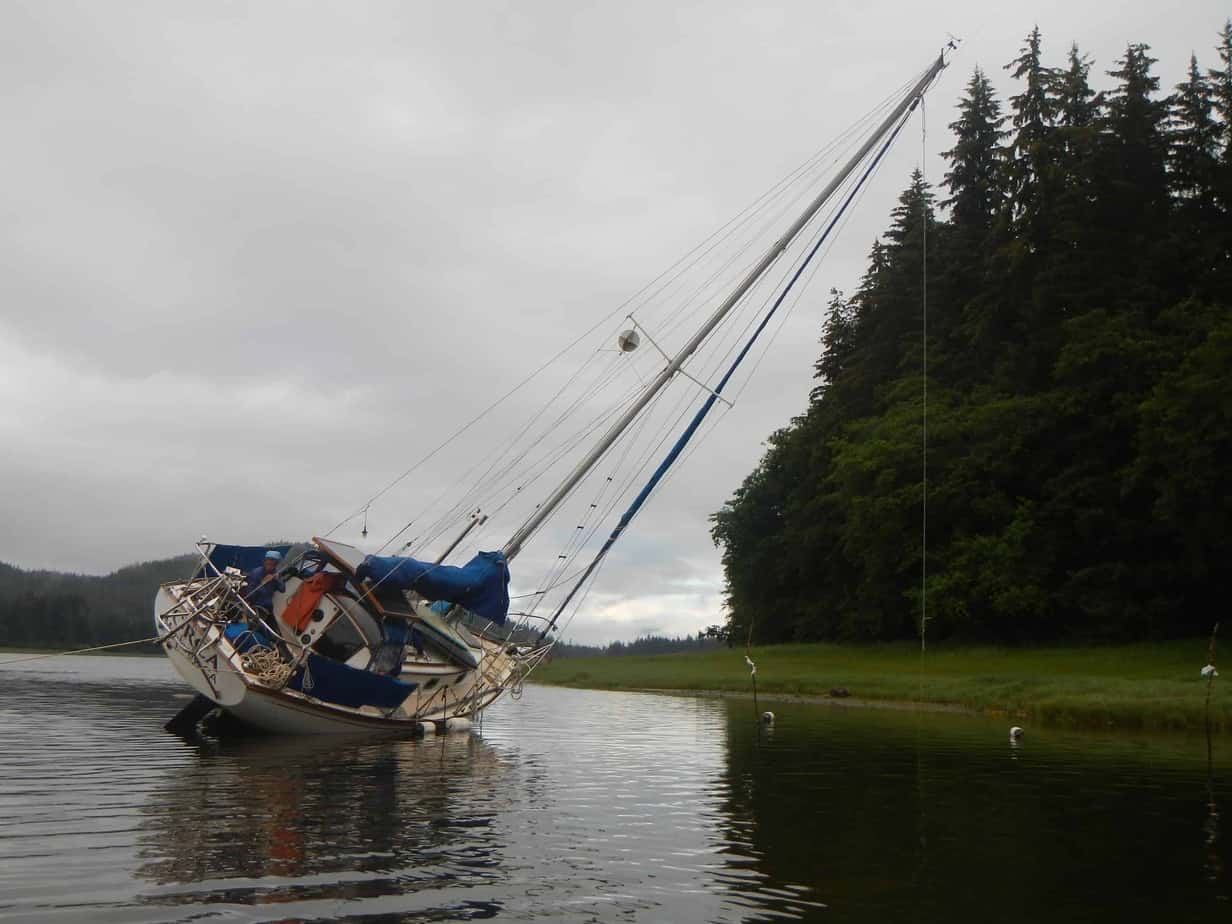
On the next falling tide, when the handkerchief peeked above water, we pointed Orca at the stake and motored ahead until the keel hissed aground. Kara fished out the fender, tied the boulder-line to the spinnaker halyard and winched it tight until we were heeling towards the woods. The hull settled over remarkably fast; in this area, the tide drops an inch a minute. After that, it was simply a matter of scraping off growth from Orca’s exposed port side, a quick roughing up and a rinse in freshwater from the nearby stream before painting.
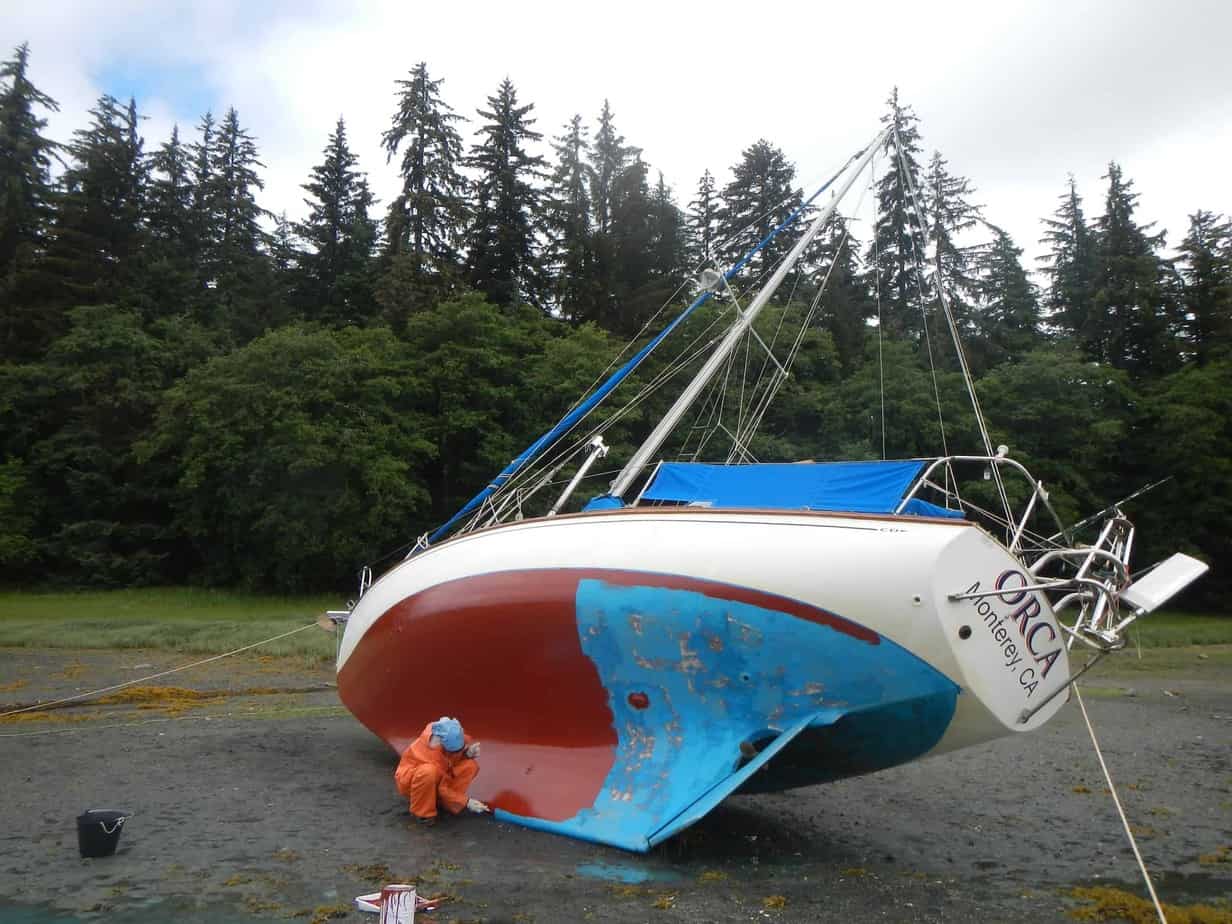
Orca floated off easily, the rising water briefly reaching the toerail before she came upright. We puttered back out to the anchorage more than a little tickled to be spending the night comfortably afloat rather than perched on blocks and stands. The next day, with more confidence, we laid her over on the opposite side and finished the job.
The other common approach to antifouling without a lift is the tidal grid–usually spaced railroad ties adjacent to piles or a pier. The boat is carefully secured fore-and-aft, athwartships, and a slight heel induced so that when the tide drops, the keel settles on the blocks and the boat balances upright, leaning lightly against the piles.
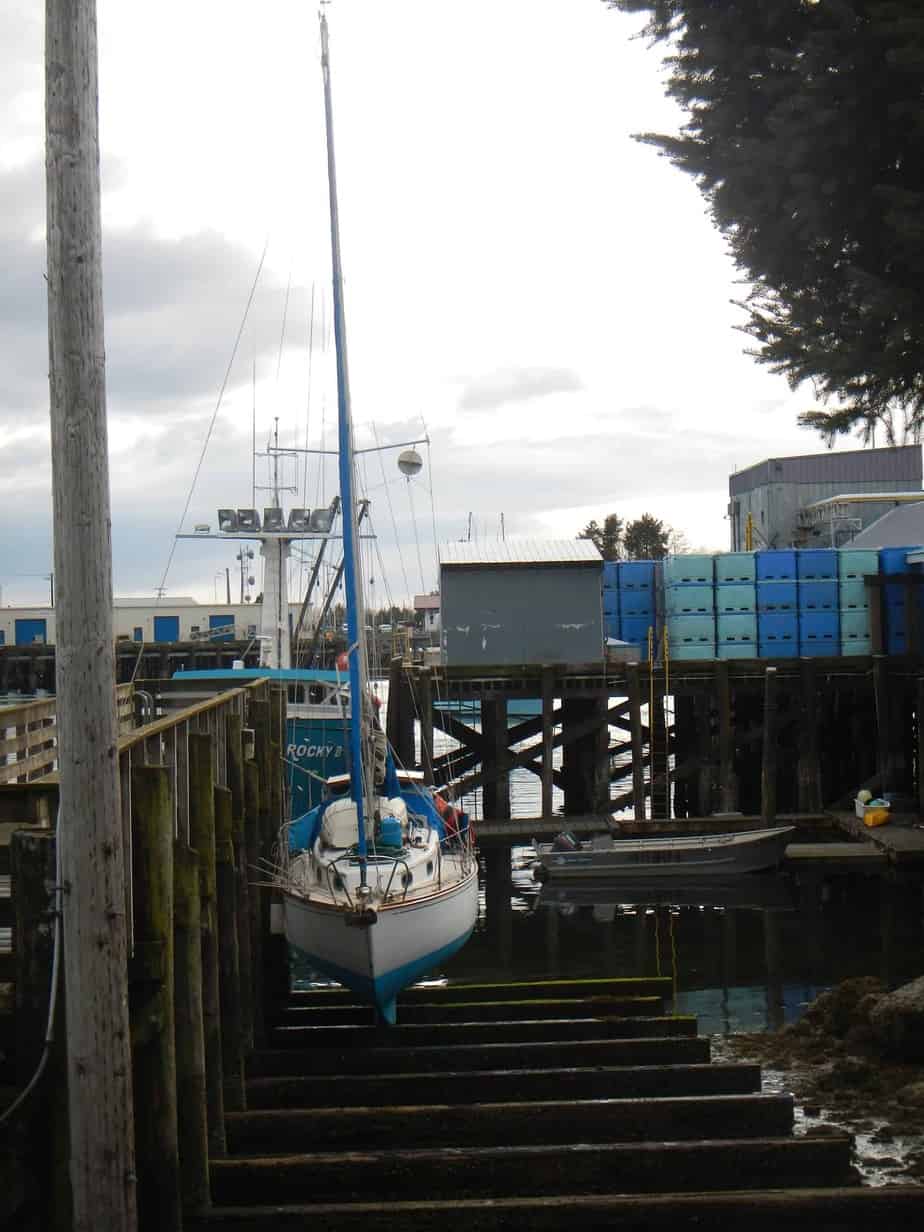
We’ve used this method as well, and while it has certain advantages–access to both sides of the hull in one tide, for example–I found it more technically challenging and, quite frankly, frightening as a novice; the cost for a misstep can be high (check this blog post by Kris on Taipan –only very quick action averted disaster). Although it takes longer, we prefer beaching for the low risk, unfettered access to the whole bottom of the keel, beautiful scenery, and the confidence to use the technique in a real emergency.
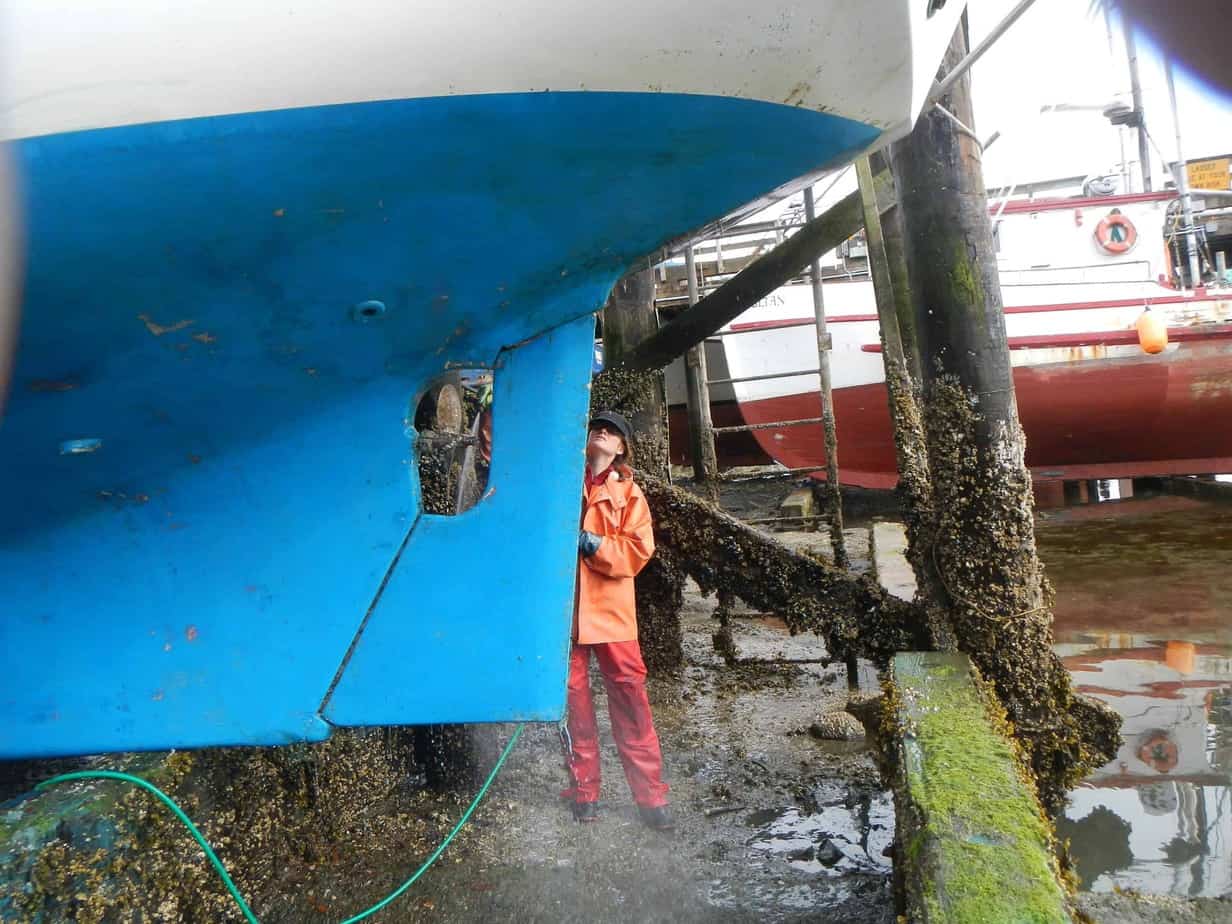
Regardless, the success of either approach depends almost entirely on preparation–the grounding takes just seconds and the opportunity to make subsequent adjustments to the boat’s position sometimes lasts only minutes.

My checklist (expanded, legible, and without the beer stains) looks like this:
- Survey the area on foot beforehand, either choosing or placing markers for both for location and depth.
- Search for sand. Mud is not only unpleasant to work in, but will swallow the bottom of the keel where it cannot be painted.
- Before grounding, check subsequent tides to make sure there will be enough water to float off. Grounding at peak high during springs would leave the boat stranded for weeks.
- The angle of heel when beached can be dramatic, especially for narrow, deep keeled designs; some on-board systems may misbehave. For example, the ends of the breathers on Orca’s water tanks end up below some areas of plumbing and leak fresh water. Close valves and turn off any systems that could cause trouble.
- Use the seconds after the keel touches to adjust the angle of the boat, either using the engine with rudder or lines to fixed objects.
- Run a halyard attached to a fixed object, or apply weight at the end of a prevented-out boom to induce heel in the desired direction.
- If there is any slope or risk of waves, ensure the boat settles leaning up hill and away from open water.
- There are special fast-drying antifouls for use in a single tide, but in our experience, given reasonably warm weather and a breeze, six hours has been sufficient for any the paints we’ve used.
Done with plenty of forethought, I believe a gentle beaching can be easier, faster, and less stressful on boat and crew than the usual arrangement of machinery, straps, cradles, props, and blocks found at most yards. And after the glow of satisfied self sufficiency and the clean-bottom boatspeed excitement wears off, I still enjoy the extra heft in my back pocket: a thicker wallet and an ace-in-the-hole if we’re ever holed when gunkholing far from the boatyard.
John howard
Monday 8th of January 2018
Our marina is not hurricane/typhoon safe. It does not have a travel lift, but it does have a really big tractor converted to pull boats out. We have a 41 foot, 18 ton sailboat that is hauled out on a custom built trailer. The typhoons here range all the way up to cat 5 and we are guaranteed to have at least 2 or more each season., so we haul out a lot.
Thursday 28th of December 2017
Yes, very clever - I recall seeing this on the movie "Master and Commander". But what do we do in the Great Lakes?
Sunday 7th of January 2018
Hmmm good question! Would love to hear about the cheap work arounds Great Lake sailors use. When we sailed on Lake Ontario, we had a trailerable boat so never ran into that issue.
Terms and Conditions - Privacy Policy
- BOAT OF THE YEAR
- Newsletters
- Sailboat Reviews
- Boating Safety
- Sails and Rigging
- Maintenance
- Sailing Totem
- Sailor & Galley
- Living Aboard
- Destinations
- Gear & Electronics
- Charter Resources
- Ultimate Boating Giveaway

Upon This Bank and Shoal of Time
- By Theresa Nicholson
- Updated: February 4, 2002
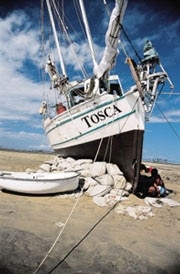
C01NICHOLSON02.jpg
After a two-year cruise through Micronesia and eastern Indonesia, our 32-foot, double-ended wooden ketch, Tosca, arrived in Balis Benoa Harbor in dire need of new bottom paint. Bali lacks a haulout facility for cruising yachts, and the thought of scrubbing the bottom all the way to Thailand wasnt exactly my idea of fun in the sun. My husband, Darrell, and I began monitoring the tidal changes on the sand flat just off Toscas bow, and a plan began to form. As the new moon approached, we decided to careen Tosca on the flat and apply a new coat of bottom paint.
With a bit of planning, careening a sailboat on a sand flat can provide a cost-efficient and convenient way to add bottom paint and execute minor repairs in harbors where haulout facilities arent available. So for cruisers contemplating exploring off the beaten track, knowing how to safely careen a boat is a valuable skill. Some boats are more suitable for careening than others, and if the procedure isnt done properly, it can lead to more serious challenges than painting the bottom.
Also, in U.S. waters, careening and painting is frowned upon, and in some areas, its illegal. Plus, paint manufacturers probably cringe at the prospect because careening seldom allows sufficient drying time to guarantee good adhesion. But in the real world, you cant always go by the book.
Finding a Flat You’ll need to find a sand flat that dries on the falling tide in an area where the tidal range is greater than the depth of your keel. Tosca draws 6 feet, and we planned our four-day careening around a spring tide with maximum tidal ranges between 6.3 and 8.3 feet. After choosing an area that offers sufficient tidal range, check the surface of the flat. We walked the flat at low tide and looked for a relatively level, hard, sandy patch that was free of rocks. We found a suitable spot to careen near the flat’s edge and marked it with two plastic bottles anchored with rocks.
At high tide, we checked the markers and noted again that the depth was just over 6 feet. We also took bearings off a few prominent trees on shore to use when we approached the flat. Next, we compared our physical survey of the area with our study of the local tide tables. We wanted to ensure that what was recorded in the tables corresponded to what we were actually observing on the flat.
We planned to spend four days on the sand flat–two days working on the port side and two on the starboard–and we wanted to leave the flat on the day with the highest tide. Turning to the tide tables, we noted the extreme low tides and tidal ranges near the time of the new moon. On the calendar, we marked the day with the greatest tidal range and counted back four days to find our starting date.
We also checked the times of the harbors daily high and low tides to see which ones fell at feasible times. On our first day, high tide was at 7:36 a.m., low at 2:13 p.m.; this was ideal. We were able to take Tosca on the flat at 7 a.m. and get a coat of paint on one side by 1:30 p.m. If our first low tide had fallen at 7 a.m., wed have had to go on the flat in the wee hours and prep and paint the boat at 5:30 in the morning.
Time and Tide Collect and organize all of your supplies before going on the flat. These will include bottom paint, sandpaper, brushes, scrapers, thinner, rollers, masking tape to mark the waterline, scrungie pads for scrubbing, rags, gloves, garbage bags, paint-stirring sticks, a drop cloth, buckets, and paint trays. Once the project starts, you’ll be working against the clock, so scope out nearby sources of such emergency supplies as paint and thinner.
Before careening, shop for quick-drying paints. We used copper-based International paint, which is readily available in most parts of the world. Also, open your bottom-paint can well in advance to see how much mixing will be required. You dont want to discover at low tide, when time truly is of the essence, that your antifouling still needs an hour of mixing.
Before going on the flat, balance the boat and clear the decks as much as possible. Have an ample supply of fresh water on hand to rinse the hull after sanding. Make plans for an alternate sink and head to be used while working on the flat. Because opening a faucet is such a reflex action, set up your drains in a way that wont interfere with a fresh coat of paint. We inserted an 8-foot length of vinyl tubing into the outside of the through-hull, just in case we forgot we were careened on a flat. Secure everything belowdecks for the extreme heel.
To make life aboard more tolerable during the ordeal, we planned to careen Tosca against a wall of sandbags rather than lay her all the way over on the flat. The day before careening, we took 30 flour sacks out to the flat and filled them with sand. We gave the boats bottom a good scrub, and to hold Tosca in position, we flaked out the three anchor lines we intended to use in addition to our chain anchor rode.
Going In This is when you really get to know your tide chart. Our tables listed the daily range of the tide and the two high tides and two low tides that occur in Benoa Harbor every 24 hours. Using the “Height of Tide at Any Time” tables in Reed’s Nautical Companion (1998; Thomas Reed Publications Inc.) or on Integrated Publishing’s website (www.tpub.com/ weather3/6b-16.htm), we were able to estimate the flat’s depth at regular intervals. Then we crafted a table that listed the exact times of the highs and lows on the four days we planned to be on the flat and the periods when the flat would be dry.
We also tried to pinpoint the times each day that Tosca would be aground and when shed refloat. Looking at our chart listings for the first day and working backward, we determined that if the low tide was at 2:13 p.m., we should finish painting by 1:30 p.m. to allow the paint at least an hour to dry. We hoped the depth would be low enough to start sanding by 10:30 a.m., giving us a couple of hours to prep the hull.
At 7 on the first morning, roughly half an hour before the 7:36 high, with our hearts in our throats we drove Tosca aground, laying out a stern anchor to starboard as we made the approach. I then lowered our bow anchor and chain rode into the dinghy, and Darrell set it about 150 feet off the starboard bow. Next, we set a stern anchor to port. Then we rowed a fourth anchor off our port bow.
By 10:15, the water on the flat was shallow enough for us to stand. Tucking the sand bags along the port hull and building a makeshift wall against which Tosca could lean took almost an hour. Movable ballast on deck–water jugs, jerricans of fuel, and the like–helped us tip Tosca to starboard, and as the tide fell, she settled against the sandbags.
Wed determined from the tide tables that we had 7.9 feet above mean low water on the 7:36 a.m. high and 1.6 feet above mean low water at 2:13 in the afternoon. The tide didnt fall low enough our first day to completely expose the keel. But on Day Two, the tide fell low enough and fast enough for us to get an additional two coats of paint on the starboard side, including the inch along the keel we were unable to cover the day before. Days Three and Four had even greater tidal ranges, and we were easily able to get several coats of paint on the port side.
The trick is planning the haulout around tides that fall low enough the first day to paint and rise high enough the last day for the boat to get off the flat. Make sure you know how many feet above mean low water youll have at high tide on the day you plan to go off the flat.
Sanding and Painting On Day One, our low tide bottomed out at 2:13 p.m., and we hoped to get the first coat of paint on the hull by 1:13 to give us that hour of drying time. While the water wasn’t low enough to paint until 12:40, we still tried to organize ourselves around that timetable. Likewise, we planned to start sanding at 9:40 a.m., but the water was still too deep then. Although our water-level calculations weren’t perfectly accurate, they helped us plan for each stage.
We spent as much time as possible prepping the hull on Day One, so we had time for only one coat on the starboard side. On Day Two, because we only needed to sand and rinse the salt residue off the new paint and because the tidal-range increase gave us more time to work, we were able to apply second and third coats to the starboard side. On days Three and Four, we followed a similar pattern on the port side. The tidal range increased each day, and by Day Four, the sand flat was completely dry two hours before and after dead-low tide.
Between Tides To avoid the wakes of vessels, we chose an area with minimal traffic, but as the tide ebbed that first day, we still bounced on the flat. We kept the movable ballast on deck, along the starboard rail, and Tosca’s hull eventually rested against the wall of sandbags while her keel settled into the sand flat.
The second high tide of the day that week was lower than the first. We went aground the first day on a high tide that was 6.3 feet above mean low water. The second high that day was only 5 feet above mean low water, so we stayed grounded. The next morning, we floated off on a 7.2-foot flood tide and had to reposition ourselves against the sandbags.
We stayed put on the second days second high (5.9 feet) and floated off on the morning of Day Three with a 7.9-foot tide. We moved the sandbags to the port side rather than move the boat on the third day. Moving the boat wouldve meant working along an edge that shoaled off at a steeper angle, leaving part of the keel underwater longer. On our final day, we had a morning high of 8.2 feet, and although the evening high was lower, at 7 feet, we still had enough water under the keel to back off the flat.
Getting Off Through the careening, we had port and starboard anchors set in shallower water on the flat and stern anchors set on both sides about 100 feet off the stern in deeper water. Once the job was complete, we no longer needed all four anchors to keep us in position. While we were still high and dry, we retrieved the chain anchor off the starboard bow and shifted the port bow anchor, on rope rode, so it lay slightly off to starboard.
When we had enough water under the keel, we backed Tosca off the flat by pulling on the stern line and letting the bow anchor rode, followed by the secondary stern anchor, free on floats. We walked the port stern anchor to the bow, which turned us into the wind and left us floating in deep water. The next day, we retrieved the anchors and, at low tide, emptied our sandbags.
Having careened Tosca for fresh bottom paint, we know we can do the same for emergency repairs. Hot, windy weather, the perfect flat, and a well-thought-out game plan helped us apply three coats of paint, and we didnt have to scrub the bottom all the way to Thailand. Now, two years later, were just about due for a new coat.
Theresa Nicholson and her husband, Darrell, live in Portsmouth, Rhode Island. Tosca lies in Malaysia.
- More: seamanship
- More How To

Grease the Wheels of Your Boat: A Guide to Proper Lubrication

A Bowsprit Reborn: A DIY Renovation Story

Rigging Redo: Our Switch to Synthetic

Top Tools for Sailboat Cruising: Must-Have Gear for 2024

Galápagos: A Paradise Worth the Paperwork

Around Alone

- Digital Edition
- Customer Service
- Privacy Policy
- Terms of Use
- Email Newsletters
- Cruising World
- Sailing World
- Salt Water Sportsman
- Sport Fishing
- Wakeboarding

- New Releases
- Author News
- Our Bloggers
Saturday, August 31, 2013
Careening, scraping off the barnacles.

7 comments:
Very interesting. Thanks for sharing.

I had no idea! Thanks for the very interesting post. I never thought about boats collecting that stuff on their hulls while in the ocean. Wonder what's the most unusual thing they've found attached to the bottom of their ships? tscmshupe [at] pemtel [dot] net

Your post was so very interesting. My family and I vacationed in the Outer Banks a few years ago and found it to be a lovely place. The lighthouses and the rescue station..I can certainly see where a writer could go there and the creative juices would start flowing. Thank you!
Fascinating! I never thought about the hull needing to be scraped! I wonder how long this process took. There is so much history in the Outer Banks; thank you for sharing these tidbits!
Today we would put the ship in drydock, right? Interesting about careening a ship by pirates. I really enjoyed The Chamomile, which I won from you. The other two in the series should be really good. I was not aware there was book 2 and 3 is on the way. Thanks, Sharon, CA wileygreen1(at)yahoo(dot)com
What an undertaking - looks dangerous also! Wooden ships certainly had their disadvantages, didn't they?
- Event calendar
- Annapolis Sailboat Show
- Fort Lauderdale International Boat Show
- Miami International Boat Show
- Oceanis 30.1
- Oceanis 34.1
- Oceanis 37.1
- Oceanis 40.1
- Oceanis 46.1
- Oceanis 51.1
- Oceanis Yacht 54
- Oceanis Yacht 60
- FIGARO BENETEAU 3
- Heritage Sailing Yacht
- Flyer 7 SUNdeck
- Flyer 7 SPACEdeck
- Flyer 8 SUNdeck
- Flyer 8 SPACEdeck
- Flyer 9 SUNdeck
- Flyer 9 SPACEdeck
- Antares 7 Fishing
- Antares 8 Fishing
- ANTARES 11 FLY
- Gran Turismo 32
- Gran Turismo 36
- Gran Turismo 41
- Gran Turismo 45
- Swift Trawler 35
- Swift trawler 41 Sedan
- Swift trawler 41 Fly
- Swift Trawler 48
- Swift Trawler 54
- Grand Trawler 62
- Heritage Powerboats
- Future Owners
- A REMARKABLE ANNIVERSARY
- Our History
- Our Architects and Designers
- Our philosophy
- Our Innovations
- Your way to ownership
- Tests and Awards

7 recommendations for maintaining your sailing yacht or motorboat!
| Careening is a key maintenance task for any boat during which you can inspect the hull and protect it against osmosis, check metal parts for corrosion and make sure that no marine organisms are present. A smooth hull enhances performance by increasing boat speed and reducing fuel consumption. Careening also helps reduce the risk of introducing invasive species from one area of water to another. It is important to do the careening in areas of the harbour that provide for the recovery and treatment of residue, including antifouling paint and runoff. There are biocide-free alternatives to antifouling paints that use silicone treatment. For paint residues and toxic waste to be treated, collect them and take them to the nearest appropriate waste disposal point.
|
This includes bilge water, cooling water from the exhaust and water from washing out the tanks. Use absorbents or a bilge pump with hydrocarbon separation by absorbent filter when cleaning the bilges, then dispose of this at the port’s waste disposal area for treatment
|
|
| When cleaning the boat’s interior (dishes, shower, head) and exterior (deck, hull, stainless steel, aluminium, fabrics, etc.), it is important to use only fully biodegradable detergents (European eco-label) that have a low impact on the waters around you. When rinsing, make sure you use as little water as possible and fit hoses with a water-stop type fitting. Good practice: rainwater can be collected and used for rinsing. Lastly, you can opt for ecological washing stations with manual washing when available.
|
Flares have a relatively short lifespan (36 to 48 months) and must be disposed of by specialized companies due to the explosive nature of the components. You will need to find out how these devices are to be destroyed in the country where you are. In France, you can return expired products to hardware stores as part of the «one bought, one taken back» policy. For more information, go to www.aper-pyro.fr
|
|
| An engine that is perfectly maintained and used correctly consumes and pollutes less. Carry out a regular maintenance check every 12 months or every 100 hours.
|
You can find biodegradable synthetic engine oils. Make sure you use them for maintenance operations of your boat |
|
| France is the first country in the world to have set up a decommissioning industry that is free for leisure sailors. Find out more from www.aper-asso.fr
|
Published on 13.05.2019
Select your area and your language
- Chinese, Simplified

A trouble-free haulout: does it exist?
Coastal sailors have it easy at haul-out time. They usually get the job done at a known facility in their home port.
Even the nomadic coastal cruiser will be familiar with, or have recommendations for the yard they are considering. But once we head out into unknown territory, we encounter a wide variety of boatyards, some excellent and some questionable.
To assist you to a trouble free haul-out wherever you go, Petrea McCarthy spoke with cruising sailor and Marine Surveyor Anthony Gates of Andaman Maritime Services in Phuket. Anthony compiled this guide to hauling out from his extensive experience with diverse boats and yards, including more than a few avoidable disasters.
Preparation
The basic planning for a haul-out begins during the previous one.
Note the details in your maintenance log: record the type of antifoul, how it was applied, how many coats and anything else that could possibly be relevant next time. Do not rely on memory because humans are great at forgetting unpleasant experiences.
Also list all other work done, like: changing anodes, replacing or servicing seacocks, repainting the boot top, and so on. With most boats, there will be jobs left over and these will form the basis of your to-do list for next time.
There is also the practical aspect to consider. Who will do the work? Will supplies be available on site, or should you prepurchase? Are you going to live aboard, or do you need to find other accommodation?
There is absolutely no point hauling out for a paint or osmosis job during the wet season with its 100% humidity and rain. However, if you choose to or need to haul-out when wet weather can be expected, consider whether a tent or tarpaulin will be required.
Insurance considerations
Insurance companies frequently require a survey of underwater surfaces and machinery on vessels over ten years old. Anthony often comes across owners who have just relaunched after their annual haul-out when the insurer requests an out of water survey before renewing the policy.
Also, be aware that some insurance policies do not cover ‘hot work’, like welding or grinding; plus some require notification of any major works, such as a refit, for example. Here is such a clause from one insurance company: “Excluding whilst under Refit or Repair other normal maintenance. Any hot work or major work during normal maintenance must be notified to Underwriters in advance. An additional terms and premium to be agreed.”
Apart from the dubious English involved, it is clear that you may not simply proceed with certain maintenance without the insurance company’s agreement.
Selecting a boat yard
Before choosing your boatyard, ask a few questions beyond the price.
Is the lift area subject to tides? When boats can only be hauled or launched within a small tidal window, any hold ups can translate to several days’ wait.
If you need to sneak into the yard on a high tide, will the tides be making or waning? Ensure that you can not only get in, but perhaps even more importantly, that you can leave without scraping your new antifouling.
Will you need to approach bow or stern first? With a travellift, also find out if you need to remove the backstay(s) or forestay. Having to take off parts of the rigging is routine if the boat is relatively large for the size of the travellift.
What is the hardstand surface? A cheaper rate for being on dirt or gravel may not be worthwhile if the boat ends up filthy. Dust can be a major issue if you want to apply any paint other than antifouling.
How will your boat be supported ashore? Adjustable cradles must support the boat at its pre-highlighted strong points.
For most, this is under the keel area or under the bulkheads. Cradles, stands, blocks and props must not be able to move, in relation to the boat or each other. If the boat can wobble at all, the whole support system can be jeopardised.
Apart from the basic charges, clarify: if the haulout charge is one-way or lift-and-return; whether electricity is charged separately and at what rate; plus whether pressure washing the hull attracts an extra charge.
Not all yards let you work on your own boat, so find out whether you will be allowed to do the work yourself. Alternatively, if you want the yard to do the work, what are the charges? Will you need to employ technicians or tradies? What are the insurance requirements?
Find out the insurance requirements. Some comprehensive policies have limited third party cover for marinas and boatyards. In Australia most boatyards and marinas require comprehensive.
Lastly, do they supply ladders or stairs? Some yards do not, to avoid insurance complications. This can be an issue for the travelling cruiser who does not have room to carry a long ladder around.
Now, what about your crew? What amenities are available? Even in the twenty-first century in Australia, at least one major yard does not have women’s showers. Whether or not they expect women to work on their boats, this is inconvenient for live-aboards.
Pros and cons of different haul out methods
The travellift is very common, particularly in Australia. The boat enters a dock between two arms, the machine manoeuvres over the boat and wide slings are passed under the hull. These are then winched up, lifting the boat vertically.
Once the boat is clear of the water, the machine trundles over to a wash down bay, then to an adjustable cradle, or a set of props. It is convenient for most boats, but does not support the centreline of the hull. This can be less than ideal for wooden boat.
The travellift obviously needs to be wider than the boat, which can be limiting, especially for multihulls. Less than a few centimetres clearance can be too stressful, and potentially damaging.
Travellifts slings can damage rubbing strips or rub rails, paintwork and antifouling, especially new antifouling. Poor positioning of the slings can cause hull pinching and damage to bulkheads. Ideally the machine will be wide enough that the sling angle is open enough not to compress the hull.
A hydraulic trailer is a large trailer with adjustable beams and supports. It is backed down a ramp under the hull, then the boat secured. It then moves forward, lifting the boat from the water much like a conventional boat trailer.
This set up is excellent for multihulls as it can support them by the beams with no crushing effect on the outer hulls. However, if the supports are not placed correctly, damage can occur.
Marina Bull Forklift is simply a large forklift with padded arms. Commonly used to lift small boats up to twelve tonnes. Similar disadvantages to the hydraulic trailer, but quick and easy for suitable boats.
The traditional slipway trolley is an adjustable cradle fitted to a marine railway. It is rolled into the water, the boat manoeuvred on to it, then pulled up until the keel begins to rest on the trolley bed.
As the boat comes further out of the water, the side arms are adjusted to support the boat upright, without crushing the hull. The weight of the boat is taken on its keel or centreline structure, with props underneath if required to keep it level fore and aft. Centreline blocks need to be adjusted to support the boat evenly, or damage can occur.
These trolleys are unsuitable for boats that are not designed to be supported by their keel, such as some modern racing yachts. Another disadvantage if the boat is being lifted for a survey is that, with the weight on the keel, it is not hanging for inspection of the keel-to-hull joint.
Boats with very short-chord keels do not sit well on such trolleys and can be prone to falling over if the keel slips, or falling on their nose.
Some yards use a simple trailer: a rubber-tyred version of a traditional slipway trolley.
Careening relies letting the boat dry out on a falling tide until the bottom is fully exposed. Limitations include insufficient drying time for painting; plus in some areas, cleaning marine growth is illegal.
The process will need repeating for the other side.
Where it is still legal, the advantage is that it is free. Careening can be useful for changing anodes, propellers, skin fittings or any other jobs that can be completed in a few hours.
Careening poles is a set of stout poles set in a shallow area to allow careening with the boat upright. These used to be common, but are less popular since the advent of fin keeled boats that tend to fall over longitudinally. Same legal issues as careening and the same advantages for quick under body jobs.
Crane – a large crane is manoeuvred over the boat, with slings passed under the hull. The crane jib is raised, or winch reeled in, to lift the boat ashore. Slings must be secured against movement, and spreader bars must be used to prevent crushing of the hull. Often the masthead instruments or mast itself are vulnerable to damage from the crane jib. Advantages are that cranes can be available in areas where there are no conventional boat yards. Disadvantages similar to the travel lift.
Once she’s out: blocking
Is the haul-out for a survey inspection? Do you need to be able to drop the rudder or keel? Will this be done by holding the boat high, or digging a hole?
block on bulkheads if possible every 3m (minimum of three blocks).
after blocking, rain water should naturally flow toward the drains. (not bow down)
blocks/chocks are to distribute load on the hull so should have maximum surface area with no point loading
jack stands or Acro props should hold the boat upright, but not support the weight of the vessel
jack stands or Acros should be chained together on most surfaces
access ladder should be secured at the top and safe to use
centreboards and daggerboards must be accessible when the boat is blocked
After blocking checks:
do doors and hatches open and close freely?
check bilges
check structural members
earthing/grounding the boat. Many boats are earthed through engines or shafts. For safety, a ground wire should be run from the earth point on the vessel to the ground.
Finally, time to launch
Do not relax just yet.
Ensure that the yard allows enough time after lifting to antifoul under supports.
This is commonly overlooked and the boat ends up with several poorly antifouled patches.
Are there drain plugs or bungs you need to replace before launching?
Once she’s back in:
turn seacocks on
check all transducers, through hulls and hoses
check and monitor the shaft seal
check the bilges
bleed up engines, genset and air conditioning units
monitor bilges.
To prevent damage, know your boat and ensure the yard is fully aware of your boat’s requirements before they lift it.
Here is Anthony’s pre-lifting checklist:
- supply the yard with photos of previous lifts and, if available, the manufacturer’s instructions for lifting
- mark the safe lifting points so they are clearly visible to the machine operator
- know the bulkhead locations
- make the boat as light as possible by emptying tanks and removing heavy items like tenders and anchor tackle
- check the position of the lifting apparatus in relation to drive gear: shafts, propellers and sail drive legs etc.; plus transducers, through-hulls with strainers and stabilisers or fins.
- remove paddle wheel transducers. Dive on the boat before lifting if necessary to be certain everything is clear
- turn off the seacocks
- ensure the vessel isn’t held for too long before being supported or blocked
- on cranes and travellifts, add padding near the rub rail to distribute the load
- reduce windage and weight aloft. This is particularly important if the boat is dry-stored during cyclone/hurricane/typhoon season. Consider removing the mast and storing it separately. At the least, secure furled sails so there is no possibility of them unfurling
- on relaunching, consider wrapping travellift slings or putting plastic between the slings and hull to minimise damage to new antifouling. Make sure these are taped on so they don’t end up in the water.
- documentation for possible evidence should something go wrong, take photos or video before, during, and after the lift.
Anthony Gates with thanks to Petrea McCarthy
Also on mysailing.

Spain presents a powerful fleet at the J/70 Worlds 2024

New season, new boats, new crews – and a brand-new threat to the established order

Early lead to Deep Blue in Rolex IMA Maxi 1 World Championship

Gold Coast Marine Jobs & Careers Expo

Gilmour consolidates overall lead on day 4 of the Kinsale Dragon Gold Cup

Team Australia Challenge 2024 are on the water

Fountaine Pajot Unveils Spacious New 41 Sailing Catamaran

Andrade takes race victory as Gilmour continues to lead on day 3 of the Dragon Gold Cup

Spotlight on Youth and Corinthian Sailors at 2025 Etchells World Championship

Home win for Women’s WMRT Denmark

Cooke and Gilmour take first blood at Kinsale Dragon Gold Cup

British lead into Louis Vuitton Cup semi-finals as France bow out in style
Join Our Newsletter
- Name First Last
- Phone This field is for validation purposes and should be left unchanged.

Read all of the latest sailing news

Dinghy and Yacht Racing News

News from the offshore world

Cruising Stories from around the world


Boats & Gear
The latest boats and yachting gear

Watch everything sailing and boating
Latest Sailing News, Racing, Cruising, Boats, Gear and more

- Forum Listing
- Marketplace
- Advanced Search
- All Topics Sailing
- Skills & Seamanship
- Seamanship & Navigation
- SailNet is a forum community dedicated to Sailing enthusiasts. Come join the discussion about sailing, modifications, classifieds, troubleshooting, repairs, reviews, maintenance, and more!
The Delicate Art of Careening
- Add to quote
| | |
| � |
- ?
- 176.3K members
Top Contributors this Month
Green Coconut Run
Adventure sailing cooperative, careening our sailboat in ecuador.

Aldebaran on the beach
One of the so-called disadvantages of a trimaran (or catamaran) while cruising? It’s harder to “haul out” for repairs because they are uniquely wide. True enough! Here is how we dealt with our rudder repairs while in a small bay in Ecuador – while saving thousands of dollars.
Water in the bilge, I tell you, is the bane of a boater. For a year water sloshed around our aft bilge due to a mis-alignment in our brand new engine mounts, installed in California; one of the bolts had wiggled loosed after 2000 miles of vibration.
Arriving in Bahia Caraquez, we met our Ecuador mechanic, Wacho, who finally solved the problem after many attempts to unsuccessfully align the engine. I mopped up the bilges in a glorious but short-lived moment of dryness.
That’s when I discovered the leak coming from the rudder.
I followed stained dribbles of water upstream and saw the rudder mount was oozing water. It had to be removed and inspected before our passage across the Pacific. To do this, the boat had to be out of the water.

Like a fish out of the water
HAUL OUT OPTIONS
I called Puerto Lucia in Salinas, a yachting harbor to the south. Would they haul us out? Nope, their travel lift wasn’t wide enough for our multihull, but they could hire a giant crane each way. Plus laydays and cost of repairs, about $8,000. Hum…

I went to Guayaquil’s Astillero neighborhood — they had boat yards for huge Navy ships and some sketchy looking yards with large fishing vessels. They quoted me $9,000 to haul the boat, paint the bottom, and stay dry 2 weeks. Dang!
I could always sail the boat back to Panama, two weeks roundtrip. I imagined it would still cost at least $5000 there, but I’m not sure.
“Why don’t you just do it here on the beach?” suggested Ariosto. He works for Puerto Amistad, the facility in Bahia Caraquez that rents moorings to cruising boats ( read about why we chose to moor here in the first place ).

On the full moon, this big power boat careened in Manta’s beach, south of Bahia Caraquez.
“Careening” — that is the term for putting a boat on the beach for repairs. You drive it ashore on a high tide, and wait for the tide to drop. Simple!
Historically, boats were designed to be able to careen easily, but no longer. Many yachts have “fin keels” which are higher performance but are more vulnerable to damage than “full keels” especially when the boat is resting at a 40-70 degree angle. Even catamarans, which should have no problem careening, are sometimes designed with their propellers and rudders lower than their keels (such as the Dolphin cat).
DESIGNING THE CAREEN
Unlike many trimarans with retractable centerboards, our sailboat Aldebaran has a fixed fin keel which is a full 3.5 feet lower than the amas (aka ‘pontoons’). The boat was built in 1968. Who knows if the keel would withstand serious angled pressure if we let her go dry? Probably she would… but I didn’t want to take the chance.
Consulting with our mechanic Wacho, and with friends stateside — my sailing mentor Matt, our boatyard foreman Tom, and do-it-all oceanographer Dave — we came up with a plan. We’d build two metal jack stands to support the weight of the amas, hence keeping the boat balanced. That way, the pressure on the keel would be vertical and safe.

Planning the careening and jack stands
JACK STANDS
Our jack stands had to support a few tons of weight, yet be foldable. Getting their height correct was difficult — I’d recommend taking those dimensions when you’re at a haul out facility, not in the murky river water as I did!
The jack stands were made of 3 inch galvanized steel and stainless components. They cost $300 for the pair, from the local welder “Socio”. Very well built, but their only downside: extremely heavy, ~45lbs each.

The big wood logs used underneath the main keel. We used thinner (2 inch) pieces under the jack stands.
WOOD BLOCKS
The other challenge: Sand on a slope. How would the boat settle into the soft sand? Would it sink slightly, lose its balance on the jack stands, and crash catastrophically? We decided to place thick wood blocks to spread out the load on the sand – under both the jack stands and the main keel. We cut these at a local sawmill and transported to the beach, at a cost of $40.

Sawing wood and making jack stands, under Wacho’s supervision.
The best location for careening is at the end of the public swimming beach in Bahia Caraquez, though sanding & painting boats was no longer allowed there. I would get bogged down with the bureaucracy if I asked permission. Instead, Wacho waltzed into the Port Captain’s office and announced that we needed to do emergency rudder repairs. A verbal OK was granted. The city environmental administrator did make a small fuss later, and claimed we would get a $500 fine if we did it again.
CAREENING DAY

The tides were perfect on Wednesday the 18th: 7:50AM high tide, 8:20PM high tide. This timing allowed us to place the boat on the beach in the morning high, and float it again on the evening high. The 3/4 moon was not creating a big tide, but the 1.8 meters (6 feet) tidal swing was sufficient for us, since the boat only has a 4.5 foot draft.
There was so much barnacle growth on the propeller that I barely had any steerage or power with the engine, but I made it to the beach, just 1/2 mile from the mooring field at Puerto Amistad.
THE SPIDER WEB
At 7:30am I dropped an anchor about 200 feet off the beach, then motored into shallows. The depth sounder read 10 feet… 6 feet… 4 feet… the boat was aground gently. I jumped off the bow and led two lines to different street lamps on the beach.

Careening in Bahia Caraquez 2
The tide was still flooding for another 30 minutes, which I estimated would introduce another few inches of water; so we could stuff the logs under the keel. There was a back-eddy along the beach which was pulling the boat along the shore, in the opposite direction I expected. I jumped in the skiff and rowed out another anchor off our beam, to stabilize our position.
DROPPING TIDE
Wacho arrived with two helpers, along with the jack stands and wood blocks. We surveyed the situation and at the last minute decided to spin the boat around, so that the stern would face the beach. This would give us more time to work on the rudder. The tide was slack and we released the four lines and spun the boat around without much problem.

Careening in Bahia Caraquez 1
Putting the logs under the main keel was the hardest part. I put 3 dive belts with 25lbs of weight strapped to a log, but it made no difference to the log’s powerful buoyancy. The best approach was to jam one end of the log under the keel, and step onto the other end (remember it’s 4 feet deep). Then, we shimmied the log further so it was pinned under the keel.
Once 3 logs were in place, we walked out the jack stands. It turned out to be a little tall since the boat had already leaning over slightly. We didn’t manage to get the jack stand under the center of the port ama. This resulted in overloading the stand and bending it slightly (the welder said he’d make some modifications to improve it). The second jack stand went perfectly under the middle of the starboard ama.
Finally, we put a short vertical log under the main hull, forward of the fin keel. There were six points of contact underneath the boat, plus two anchors and two lines to the beach. The boat was stuck and apparently stable. Success!
THE REPAIRS
Now it was time to do the repairs! As the water receded, our two helpers scraped feverishly at the barnacles, to remove them before they dried out in the sun. I disconnected the rudder to drop it. Because of the angle of the beach, there wasn’t enough space for the rudder to drop. We had to wait for the water to recede more, then dig a hole for the rudder to fall into.

Wacho finally removed the rudder mount about five hours after the high tide. Good news! The wood underneath the rudder mount looked perfect (no rot!). The mount itself had bent slightly concave (causing water to leak in), so he ran it to a machine shop to “re-flatten” the base. The clock was ticking…
RISING TIDE
The boat was high and dry, and the water started to come back up around 2pm. Nothing like the rising tide to motivate fast work!
I tackled the other repair: a new depth sounder. A year prior, our primary depth sounder stopped working, but we had a secondary unit (a Garmin Echomap 70s Fishfinder) to keep us going.
Now I installed a sounder with a real-time speedometer – basically a tiny spinning wheel under the hull – which would give us information about depth and currents when entering atoll passages in French Polynesia. It was a two hour installation job.
Wacho returned around 3pm with the smooth, beautifully machined rudder mount. We caulked it thoroughly with Sikaflex and mounted it with the 4 big lag screws. The rudder was pushed back into place. Both the rudder and the depth sounder – the two “holes” in the bottom of the boat – were sealed properly about four hours before the evening high tide. The repairs were done but the careening wasn’t over yet!

FLOATING AGAIN
As the tide entered the bay, there was a lot more surge and water movement. There was a concern that, as the water was nearly floating the boat, it could jostle around the ama and damage them on the jack stands.
We remained vigilant, watching from the beach with beers in hand. Around 7pm we began removing logs and jack stands as soon as they freed themselves. The beach lines were untied and the boat floated on its anchor. Ahhhhh…. What a relief.
ONE DAY VS. MULTIPLE DAYS
Careening for one day worked for us. We got really lucky that everything went as well as we could have hoped. If we had to, we could to repeat the performance the following day. We even had big conical wood “plugs” to plug up the holes overnight if needed. But we didn’t use them.
What if you needed multiple days careened? No problem. After the extreme tide of the full moon (or new moon), each subsequent high tide has less water than the previous. Once the boat is stuck, it wouldn’t re-float until the tide reaches a high enough level again — 7 to 10 days later. This is a bigger commitment though!
TOTAL COSTS
- $350 Wacho (priceless)
- $300 jack stands (we’ll keep)
- $40 wood blocks
- $80 two helpers
- $10 lunch for 4
- $20 machining the rudder mount
- $15 Sikaflex tube
- 1 week of pure anxiety
= $815, not counting the new depth sounder (compared to $8000, the lowest quote for the same job, from Puerto Lucia in Salinas)
Depth Sounder Note : B744V for the Raymarine i70s . I picked this sounder because it was the only bronze unit that had speed and depth in one. Downside is that it has a HUGE “fairing block” that is a mandatory installation (essentially for angled hulls or fast power boats). Due to the added 2 inches of the fairing block, we barely had enough height on the sounder’s throat to properly tighten the required nuts on the inside – despite the fact that we have a very “thin” hull (1 inch, plus backing plate). I would advise anyone getting this unit to purchase the B744VL instead, which is longer.

Happy to be floating again! Enjoying coffee with our new creamer container, thanks to Jackie & Jean-Claude!
This was my first time careening a boat. Some said it would be easy, others said it was really dangerous. I was stressed for the entire week in anticipation! I wouldn’t underestimate the risk and danger of this operation. I carefully evaluated the beach during low and high tide for days, and consulted with multiple people, to tend to the specific needs of my boat.
Biggest take away: you need lots of wood blocks and “shims” to stuff under the boat to ensure it’s well balanced on hard sand, ideally.
And huge thanks to Wacho for supervising the operation! Now that I have the experience, and the jack stands built for the boat, I could do it again with confidence… it’s like having your own portable boatyard wherever you go in the world!
——————————
Want to know anything in specific, or enjoyed reading the blog? Holler in our comments section below.
Related Posts:
Mooring the Boat: Our Experience in Nicaragua and Ecuador, Part 1
Mooring the Boat: Our Experience in Nicaragua and Ecuador, Part 2
Bringing Solar Lights to Ecuador’s Earthquake Victims
Share this:
7 thoughts on “ careening our sailboat in ecuador ”.
Awesome story and adventurel, glad it had a happy ending! Some too late to help thoughts but in case you need to do it again… using some crushed rock, shells, etc under the jack stand with some roofing fabric would also help stabilize those jack stands in wet sand. And soaking the logs for a few days beforehand to make them water logged would require less ballast to keep them down in 4 feet of water. Looking forward to following and hopefully joining the adventure!
Brilliant suggestions Dave! Thanks. Next time, we’ll just have to fly you out for moral support and your expertise. Looking forward to getting you out here soon!
Harrowing in the slowest way. Well done team!
Thanks Rob dog! It was like slowly pulling teeth… but fortunately, the dentist was good!
Pingback: New Cockpit Roof! | Sailing Green Coconut Run
How do you paint the bottom?
Hey Travis! Greetings from Galapagos! We didn’t get a chance to paint the bottom while careening in Bahia Caraquez. In theory the bottom paint just needs minimum 30 minutes to dry before going into the water, better if it’s 2 hours. Plenty of time between tides. Sailors careening to paint the bottom say they clean the hull & inspect for damage on one tide, then on the next day will paint. If it’s a monohull, paint one side one day, then the other side the next day. For us, the municipality in Bahia Caraquez didn’t actually give us the permit to paint since it’s a swimming beach, and the designated maintenance area was really muddy and soft next to Puerto Amistad – so I wasn’t too keen on it. They do have plans to compact the mud with gravel and substrate and actually put in pilings to tie up to, as a fancy form of careening, which they call a “tidal grid”. This should be ready in Puerto Amistad sometime in the next few months. For now, we’re just diving every other day to scrape the little barnacles off Aldebaran’s hull!
Comments are closed.

- Already have a WordPress.com account? Log in now.
- Subscribe Subscribed
- Copy shortlink
- Report this content
- View post in Reader
- Manage subscriptions
- Collapse this bar
Visit our Popular Forums
- Monohull Sailboats
- Multihull Sailboats
- Powered Boats
- General Sailing
- Antares Yachts
- Fountaine Pajot
- Lagoon Catamarans
Cruising Business
- Boat Classifieds
- General Classifieds
- Crew Positions
- Commercial Posts
- Vendor Spotlight
Life Aboard a Boat
- Provisioning: Food & Drink
- Families, Kids, & Pets Afloat
- Recreation, Entertainment, & Fun
- Boat Ownership & Making a Living
- Liveaboard's Forum
Seamanship, Navigation & Boat Handling
- Seamanship & Boat Handling
- Training, Licensing, & Certification
- Health, Safety, & Related Gear
- Rules of the Road, Regulations, & Red Tape
Engineering & Systems
- Const. / Maint. / Refit
- Product / Service Reviews
- Electronics: Comms / AV
- Electrical: Batts / Gen / Solar
- Lithium Power Systems
- Engines & Propulsion
- Propellers & Drive Systems
- Plumbing / Fixtures
- Deck Hdw: Rigging / Sails
- Aux. Equipment & Dinghy
- Anchoring & Mooring
Photo Categories
- Member Galleries
- Life Onboard
- Sailing in the Wind
- Power Boats
- Cruising Destinations
- Maint. & Boat Building
- Marine Life
- Scuba Diving & Divers
- General Photos
Recent Photos

Listing Categories
- African Cats
- view more »
- Crew Wanted
- Crew Available
- Enhance Your Account
- Meet the Mods
- Meet the Advisors
- Signup for The Daily Cruiser Email


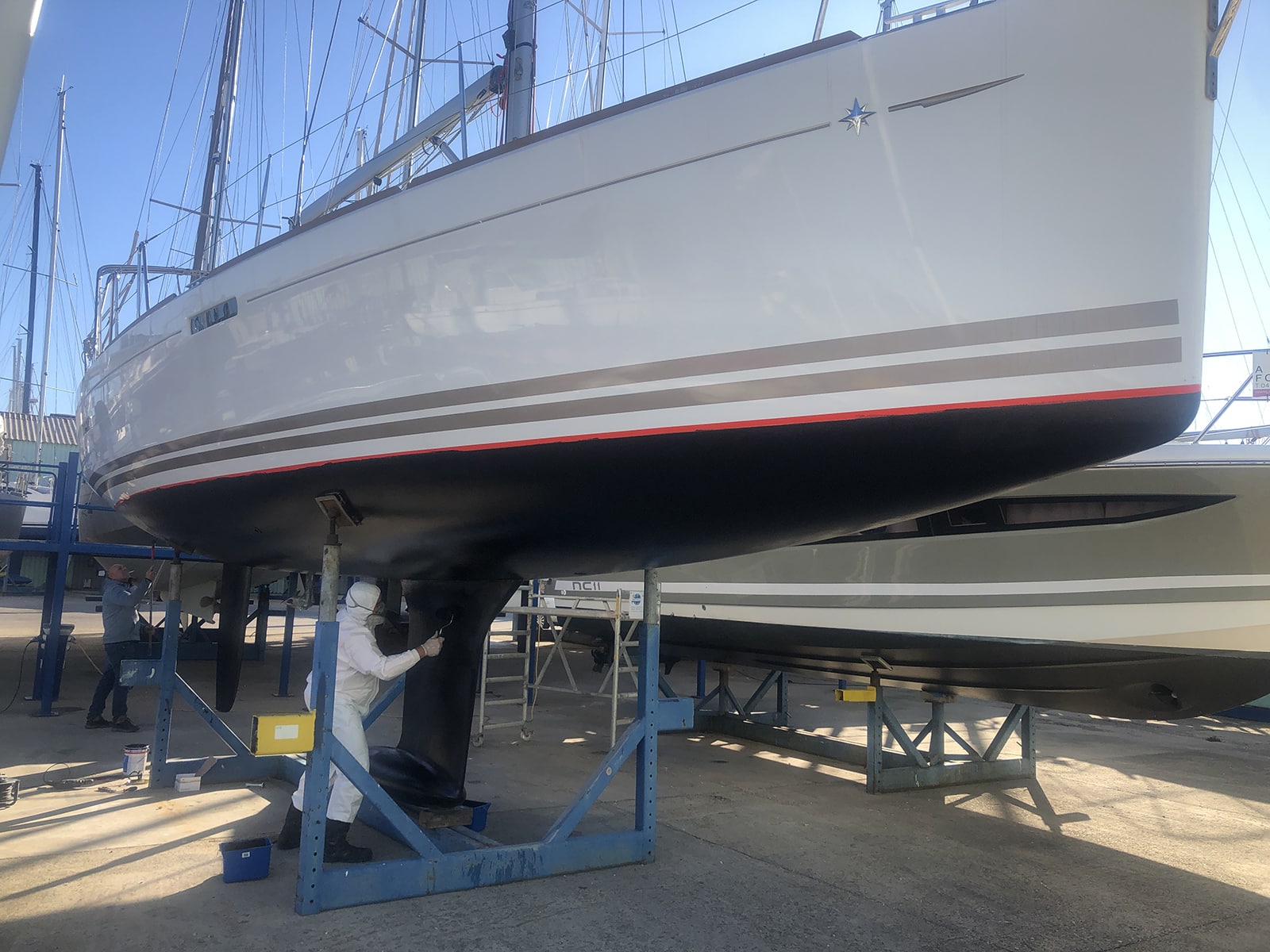
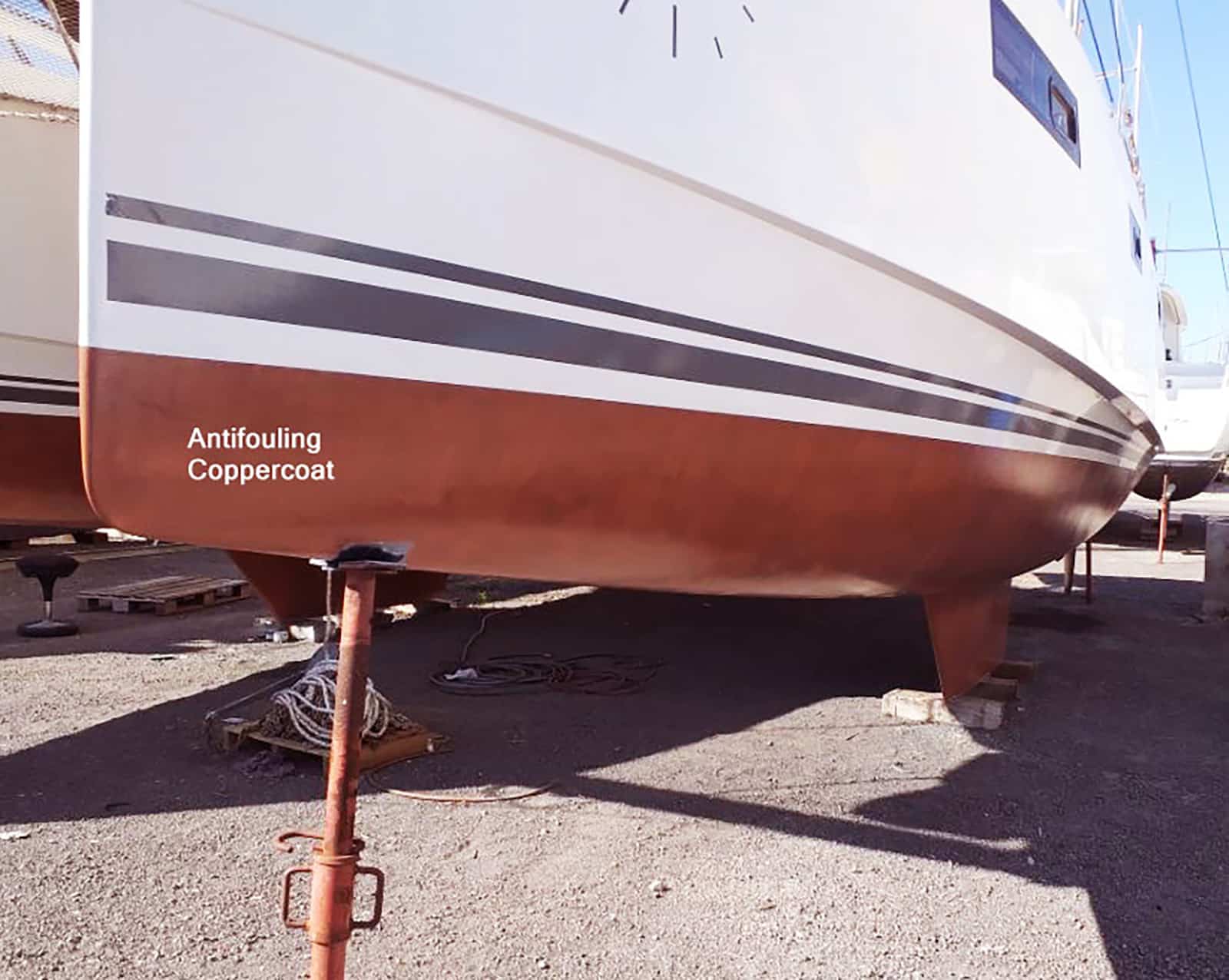


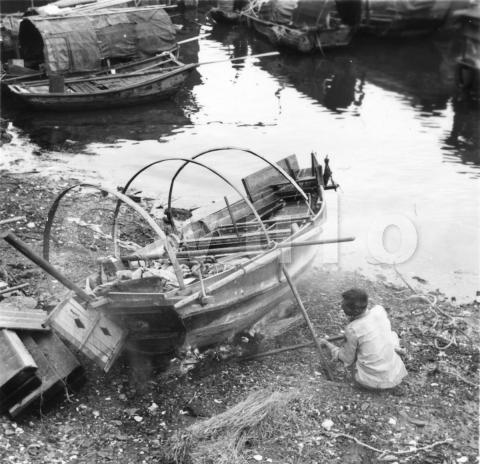



IMAGES
VIDEO
COMMENTS
Careening in the traditional sense can only be done on a sailing vessel as its masts are used for hauling it over. Today, larger ships are placed in dry dock; [5] smaller vessels can be lifted from the water by a crane or a travel lift. A procedure known as careening is still sometimes done with smaller boats, but differs from what was done historically in that the boat is not winched over by ...
How to careen a sailboat. Usually, I can talk my wife, Kara, into a refreshing swim to defoliate the fouled hull. And was it ever foul; over the winter some sort of orange slime infestation had coated Orca's sleek hull in what looked like melted cheese.. Kara is usually an avid snorkler, but I was getting nowhere in this quest for a spring hull cleaning.
Careening is the act of beaching your boat in shallow water at high tide so that when the tide goes out, the hull is exposed and dry. This allows repairs and bottom work to take place in locations where dry docking is not viable or available. Pirates were famous for doing this in the Caribbean, and favored beaches for careening were called ...
Careening (also known as "heaving down") is a method of gaining access to the hull of a sailing vessel without the use of a dry dock. It is used for cleaning...
With a bit of planning, careening a sailboat on a sand flat can provide a cost-efficient and convenient way to add bottom paint and execute minor repairs in harbors where haulout facilities aren t available. So for cruisers contemplating exploring off the beaten track, knowing how to safely careen a boat is a valuable skill.
Careening (also known as "heaving down") is the practice of grounding a sailing vessel at high tide in order to expose one side of its hull for maintenance and repairs below the water line when the tide goes out. The photo shows an opportunistic example of an early season careening. Note the...
One practice is called "careening," turning a wooden ship on its side to expose the hull. It was the most dangerous time for pirates as it made them vulnerable to attack. Ships' hulls would become thick with grasses, seaweed, worms, mold, and organisms such as barnacles making the ships difficult to steer. Since speed was critical to ...
Careening and maintaining wooden vessels was an everyday part of Lowcountry life in centuries past. < Charleston Time Machine · Episode 239: Careening across ... or sturdy wharf—to support the mass of the vessel. To careen a row boat, canoe, dory, or yawl, for example, several hands could simply drag it on a beach a low tide and manually ...
1/ CAREENING. Careening is a key maintenance task for any boat during which you can inspect the hull and protect it against osmosis, check metal parts for corrosion and make sure that no marine organisms are present. A smooth hull enhances performance by increasing boat speed and reducing fuel consumption. Careening also helps reduce the risk ...
1/ CAREENING . Careening is a key maintenance task for any boat during which you can inspect the hull and protect it against osmosis, check metal parts for corrosion and make sure that no marine organisms are present. A smooth hull enhances performance by increasing boat speed and reducing fuel consumption. Careening also helps reduce the risk ...
Careening while floating would be called HEELING THE BOAT. Heeling the boat to bring a damaged section above the waterline for inspection or repair is entirely routine and unremarkable, that's probably why you'd find so little written about it. The dog whisperer says, it is the difference between "Lie down" and "Give me your paw".
Careening relies letting the boat dry out on a falling tide until the bottom is fully exposed. Limitations include insufficient drying time for painting; plus in some areas, cleaning marine growth is illegal. The process will need repeating for the other side. Where it is still legal, the advantage is that it is free.
Careening is the time-honored way of cleaning, painting, maintaining, and repairing boat and ship bottoms. All early mariners took time to careen their ships, and until recently, it was also a technique often employed by cruising sailors. For several reasons careening is rarely done these days.
The tide was slack and we released the four lines and spun the boat around without much problem. Careening in Bahia Caraquez 1. Putting the logs under the main keel was the hardest part. I put 3 dive belts with 25lbs of weight strapped to a log, but it made no difference to the log's powerful buoyancy.
To careen a vessel one needs a suitable location, the bottom must be sandy, a muddy bottom would cause her to sink into the mud and a rocky bottom would likely cause damage, a large tidal range is also necessary, and the bank must be relatively flat. There's plenty of suitable spots around Moreton Bay, but they would involve at least a full ...
Careening in the vertical sense - we do that regularly, as shown. There was a mishap here a couple weeks back where a fellow ended up with his boat leaning away from the pilings on the grid and it flopped over hard when the tide dropped.
"Careening? I think it might be a useful idea. If done at the right time and place." AND with the right boat.We've careened our catamaran without issue. Make sure to scope the area beforehand to ensure the bottom has appropriate firmness and no rocks (the boat could settle on them, resulting in damage). As mentioned, fore and aft anchors (or aft line tied to stout object on shore).
Careening. Year after year, careening is a must for almost every ship. Annual or permanent antifouling of the Coppercoat type, polishing of the gelcoat, cleaning of shafts, propellers and thrusters, replacement of anodes... are everyday subjects for the yachtsman but require genuine expertise to ensure you get the best advice. ... On a new boat ...
Oct 2, 2008. #2. On a lightweight displacement or planing hull careening at the dock is an easy thing to do; if there are long finger piers you wont even need a dinghy. Just be sure that you know the 'balance point' so that you dont pull the boat over too far .... and then have a very embarasing episode or possible 'sinking'.
The first mention of Aberdeen's careening beaches in western sources was John Kendrick's report in 1794 that subsequently reappeared, first in Alexander Dalrymple's nautical instructions for the route to Canton, and then in Horsburgh's India Directory (what happened next is an interesting story for another time). In local argot the small islands that sheltered the beach from the swell that ...
Nov 26, 2018. #15. Capt jgw said: That's sort of way they used to do it on the old sailing ships. Run her around at almost high tide and do the bottom as the tide falls. Then do the other side on the next cycle. Just have to be careful that the next high is at least as high as the one you careened on. That would mean doing it on the ascending ...
Being a risk taker, I did it last weekend. I have a small cove in a protected inlet. The waterfront in front of my house has rocky outcroppings, but the cove has a pebble/shale beach about 30 feet wide. I ran the boat ashore at high tide (9 foot tide at 7:00 AM) and ran the halyard over to a rock so the boat would lie on the port side.
We came back to Aquarius after two months, therefore now is the time to check the systems, do some upgrades and most importantly - we already knew since Pemb...